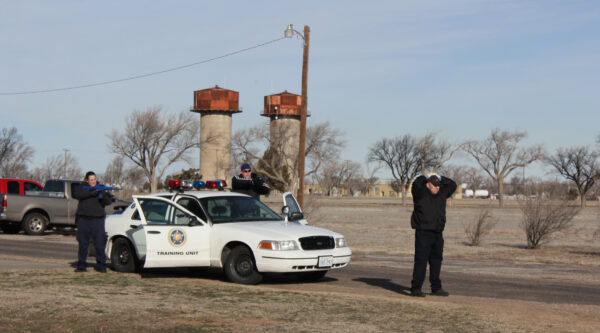
The future deputy cautiously enters the seemingly empty building. Her flashlight provides the only light as she searches and clears each room, but it also provides her location to any enemies.
Her heart is pounding, sending adrenaline throughout her body. Danger could be around any corner. She attempts to slow her heartbeat as she searches the last of the rooms.
And then: SPLAT.
This student has become the newest victim of a simulation.
Similar scenarios are conducted in the law enforcement training academy at Amarillo College.
However, the practice is safe and the gun that claimed this victim is loaded with colored soap.
Hank Blanchard, coordinator of law enforcement, said the simulation usually is everyone’s favorite part of the course.

Although safe, the scenario provides students with an idea of what similar situations will feel like. Officers risk their lives daily to serve and protect. Even things that seem exciting can involve paying a price.
“Car chases won’t be like racing go-karts,” said Caleb Pope of the Randall County Sheriff’s Department. “There’s serious stuff that you have to worry about, like if the suspect has a gun. It’s not going to be like a Hollywood car chase.”
The 800-hour academy lasts about five months with an average enrollment of 18 to 24 students.
Blanchard said the program has 33 sections and that it is up to the standards of the Texas Commission on Law Enforcement.
“I always wanted to go into law enforcement,” Pope said, “I want to help people, and being a deputy gives me that opportunity.”
During the first semester, the course covers topics such as the Constitution, the Bill of Rights, the penal code and drug laws. During the second semester, however, the course consists of spending the day at the firing range, handling patrol cars, participating in simulations and understanding the mechanics of making an arrest.
Instructors teach the students how to properly handle and diffuse situations by communicating.
“The program is excellent for anyone interested in the law,” Pope said. “If you have the drive and dedication, then this class is good to have in your back pocket.”
To enroll in the class, students must be 21 or older, have at least a GED and have no criminal record. Once students graduate from the academy, they can work as a peace officer.
“Most of the students go to work as deputies in sheriff’s departments or police departments in smaller communities like Childress or Borger,” Blanchard said.
The academy provides a foundation for further education. Graduates can attend a four-year university to become federal officers or game wardens. Most police departments offer pay incentives to those with advanced law enforcement degrees.

Leave a Reply